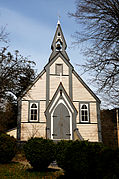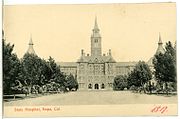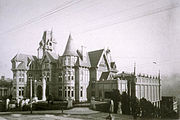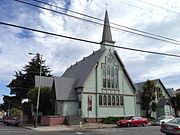User:JPRiley/Wright
| This is not a Wikipedia article: It is an individual user's work-in-progress page, and may be incomplete and/or unreliable. For guidance on developing this draft, see Wikipedia:So you made a userspace draft. Find sources: Google (books · news · scholar · free images · WP refs) · FENS · JSTOR · TWL |
John Wright (1830-1915) was a Scottish American architect noted for his work in British Columbia and the San Francisco Bay Area in the nineteenth century.
Life and career[edit]
John Wright was born May 15, 1830 in Killearn, Scotland. Wright immigrated to Canada in 1845, settling with relatives near Guelph, Ontario. He trained there as a carpenter, and established himself as a contractor. In 1856 he was appointed inspector of works for the new Guelph City Hall, which was designed by William Thomas. In 1858 he entered government employ, and was sent to Victoria, British Columbia to design and superintend the construction of lighthouses. In that capacity he was the designer of Fisgard Lighthouse, completed in 1860. By 1859 he was independently working as an architect, and was the first professional architect to practice in British Columbia. In 1861 he formed a partnership with George H. Sanders, who was born in England in 1837. Wright & Sanders practiced in Victoria for the next six years, designing a variety of buildings including houses, churches and Congregation Emanu-El, the oldest synogogue on the west coast of North America. In 1866 they entered and won an architectural competition to design the new Asylum for the Deaf, Dumb and Blind in Berkeley, California. Due to the project's size and complexity, they relocated to [[San Francisco] in 1867. In 1868 they also won a competition to design the new campus of the University of California, Berkeley, but refused the job over a compensation dispute.[1]
Wright was even more productive in San Francisco. In addition to churches, he designed houses for men like Mark Hopkins Jr. and Alfred A. Cohen, the campus of the San Francisco Theological Seminary, the Napa State Hospital, Lick Observatory on Mount Hamilton and some of San Francisco's earliest skyscrapers. Wright retired from practice in 1895, though Sanders continued the Wright & Sanders office for at least ten more years. The bulk of their work was destroyed in the 1906 San Francisco earthquake, and only a half dozen of their major buildings remain in California.[1]
Personal life[edit]
In 1858, Wright married Agnes Scott Armstrong, the daughter of a leading Guelph businessman. They had ten children, and she died in 1890. In 1868 his partner Sanders married her sister. After his retirement, Wright spent the bulk of his time traveling. He died August 23, 1915 in Victoria while en route to Ontario.[1]
Architectural works[edit]
- First Methodist Church, Pandora Ave and Broad St, Victoria, British Columbia (1859, demolished)[1]
- Fisgard Light, Victoria, British Columbia (1859-60)[1]
- Race Rocks Light, Race Rocks, British Columbia (1859-60)[1]
- House for James Bissett, 140 Government St, Victoria, British Columbia (1861)[2]
- Nanaimo Methodist Church, Wallace St, Nanaimo, British Columbia (1861, demolished)[1]
- Church of St. John the Divine, Douglas St, Yale, British Columbia (1862)[1]
- Dickson, Campbell & Company Store, 1900 Store St, Victoria, British Columbia (1862)[1]
- Congregation Emanu-El, 1461 Blanshard St, Victoria, British Columbia (1863)[1]
- First Presbyterian Church, Blanshard St and Pandora Ave, Victoria, British Columbia (1863, demolished)[1]
- House for Richard Carr, 207 Government St, Victoria, British Columbia (1863)[2]
- "Point Ellice House" for Charles W. Wallace, 2616 Pleasant St, Victoria, British Columbia (1863)[1]
- Angela College (former), 923 Burdett Ave, Victoria, British Columbia (1866)[1]
- California State Asylum for the Deaf, Dumb and Blind, 2601 Warring St, Berkeley, California (1867-69, burned 1875)[3]
- Calvary Presbyterian Church, Powell St and Geary Blvd, San Francisco, California (1869, demolished 1900)[1]
- Friedlander's Building, California and Sansome Sts, San Francisco, California (1869, demolished)[1]
- First Congregational Church, 491 Post St, San Francisco, California (1870, destroyed 1906)[4]
- First Methodist Church, Powell St, San Francisco, California (1870, demolished)[1]
- Oakland High School, Market and 12th Sts, Oakland, California (1870-71, demolished c.1895)[5]
- The White House, Kearny and Post Sts, San Francisco, California (1870, destroyed 1906)[1]
- Central Presbyterian Church, Tyler St, San Francisco, California (1872, demolished)[1]
- Central Pacific Railroad Office Building, 4th and Townsend Sts, San Francisco, California (1873, demolished)[1]
- Napa State Hospital, Napa, California (1874-75, demolished 1949)[6]
- McCreery Building, Pine St, San Francisco, California (1876, destroyed 1906)[1]
- California State Asylum for the Deaf, Dumb and Blind, 2601 Warring St, Berkeley, California (1877-78, demolished)[7]
- House for Mark Hopkins Jr., 999 California St, San Francisco, California (1877-78, destroyed 1906)[8]
- "Bellrose" for John Garber, Claremont Ave, Berkeley, California (1880, demolished)[1]
- Cooper Medical College, Webster and Sacramento Sts, San Francisco, California (1881, demolished 1972)[1]
- Lick Observatory, 7281 Mt Hamilton Rd, Mount Hamilton, California (1881)[1]
- St. Stephen Episcopal Church (former), 864 Fulton St, San Francisco, California (1881)[1]
- Eagle Block, Pine and Davis Sts, San Francisco, California (1882, destroyed 1906)[8]
- First Presbyterian Church, Sacramento and Van Ness Sts, San Francisco, California (1882, demolished)[1]
- Odd Fellows Building, 26 7th St, San Francisco, California (1884, destroyed 1906)[8]
- Pioneer Hall for the Society of California Pioneers, 24 4th St, San Francisco, California (1884-85, destroyed 1906)[9]
- Pacific Union Club, Post and Stockton Sts, San Francisco, California (1885, destroyed 1906)[1]
- St. James Episcopal Church, 1540 Twelfth Ave, Oakland, California (1886)[10]
- Lachman Block, Market and Fremont Sts, San Francisco, California (1887, demolished)[1]
- First National Bank Building, Sansome and Bush Sts, San Francisco, California (1888, destroyed 1906)[1]
- James Lick Baths, 165 10th St, San Francisco, California, (1890, damaged and rebuilt 1906)[11]
- First Swedenborgian Church of the New Jerusalem, 1640 O'Farrell St, San Francisco, California (1891, demolished)[12]
- Pacific Mutual Life Insurance Company Building, 500 Montgomery St, San Francisco, California (1891, destroyed 1906)[13]
- Montgomery Hall, San Francisco Theological Seminary, San Anselmo, California (1892)[1]
- Montgomery Memorial Chapel, San Francisco Theological Seminary, San Anselmo, California (1893)[10]
- Scott Hall, San Francisco Theological Seminary, San Anselmo, California (1897)[1]
Gallery of architectural works[edit]
-
Church of St. John the Divine, Yale, British Columbia, 1862.
-
Calvary Presbyterian Church, San Francisco, California, 1869.
-
Oakland High School, Oakland, California, 1870-71.
-
Napa State Hospital, Napa, California, 1874-75.
-
House for Mark Hopkins Jr., San Francisco, California, 1877-78.
-
Montgomery Hall, San Francisco Theological Seminary, San Anselmo, California, 1892.
-
Montgomerey Memorial Chapel, San Francisco Theological Seminary, San Anselmo, California, 1893.
-
Scott Hall, San Francisco Theological Seminary, San Anselmo, California, 1897.
Notes[edit]
References[edit]
- ^ a b c d e f g h i j k l m n o p q r s t u v w x y z aa ab ac ad John Wright
- ^ a b Danda Humphreys, Government Street: Victoria's Heritage Mile (Victoria: Heritage House, 2012)
- ^ Harvey Helfand, University of California, Berkeley: An Architectural Tour (New York: Princeton Architectural Press, 2002)
- ^ "New Church Edifice," Daily Alta California, July 26 1870, 1.
- ^ Fourth Biennial Report of the Superintendent of Public Instruction of the State of California for the School Years 1871 and 1872 (Sacramento: State of California, 1871)
- ^ Patricia Prestinary, Napa State Hospital (Charleston: Arcadia Publishing, 2014)
- ^ Warring Wilkinson, "The 'Homes' of the California Institution," American Annals of the Deaf and Dumb 23, no. 1 (January 1878): 40-46.
- ^ a b c "Wright & Sanders" in The Industries of San Francisco, ed. Fred. H. Hackett (San Francisco: Payot, Upham & Company, 1884): 83.
- ^ Willard B. Farwell, "The Society of California Pioneers III," Overland Monthly (April 1897): 370-378.
- ^ a b Susan Dinkelspiel Cerny, An Architectural Guidebook to San Francisco and the Bay Area (Salt Lake City: Gibbs Smith, 2007)
- ^ "The Lick Baths," California Architect and Building News 9, no. 3 (March 18 1890): 34.
- ^ "New Jerusalem Church," California Architect and Building News 12, no. 10 (October 1891): 114.
- ^ "City Building News," California Architect and Building News 12, no. 3 (March 1891): 35.













